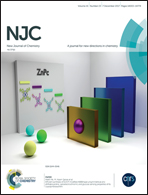Visible-light active tin selenide nanostructures: synthesis, characterization and photocatalytic activity
Abstract
A simple approach to synthesizing tin selenide nanostructures showing superior photocatalytic performance with variable tin ratios via a facile chemical method is reported in this study. The crystalline phase, morphology, oxidation states of elements, surface composition and optical properties of the photocatalysts were investigated by X-ray diffraction (XRD), scanning electron microscopy (SEM), X-ray photoelectron spectroscopy (XPS), and UV-vis spectroscopy, respectively. The photocatalytic activity was evaluated by the degradation of methylene blue (MB) under visible-light irradiation, indicating that SnSe exhibits excellent photocatalytic performance with a maximum % degradation efficiency of MB up to 92.91% after 40 min of light irradiation. These materials were also used as photocatalysts for the degradation of Congo red (CR) and the results showed 98% degradation of Congo red which is much higher than other photocatalysts. The possible degradation pathway is also presented. Indeed, SnSe nanostructures with variable tin ratios behaved as highly efficient photocatalysts and could be promising for future industrial applications for wastewater treatment.



 Please wait while we load your content...
Please wait while we load your content...